

Optimistic? SA Energy Minister says helpfully “The grid blowing up is not the right term” South Australia has built unreliable generators on one third of all homes in the state.
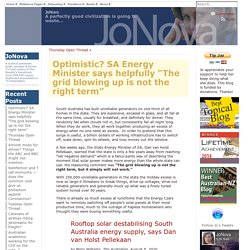
They are expensive, encased in glass, and all fail at the same time, usually for breakfast, and definitely for dinner. They randomly fail when clouds roll in, but consistently fail all night long. When they do work, they all work together, producing an excess of energy when no one need an excess. In order to pretend that this surge is useful, a billion dollars of working infrastructure has to switch off, scale down, spin its wheels, and toss money out the window. A few weeks ago, the State Energy Minister of SA, Dan van Holst Pellekaan, warned that the state is only a few years away from reaching “net negative demand” which is a fancy-pants way of describing the moment that solar power makes more energy than the whole state can use.
Rooftop solar destabilising South Australia energy supply, says Dan van Holst Pellekaan by Perry Williams, The Australian, August 5, 2020. SA: Still at risk of blackout, one third of solar PV “switching off” to save state, needs $1.5b interconnector bandaid to NSW. A $1,500 million dollar emergency line is needed to rescue South Australia from renewable blackouts.
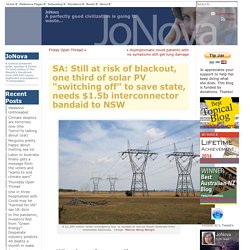
Image: Marcus Wong Wongm Why do so few see the enormous subsidy cost of keeping the South Australian electricity experiment alive? Having got too much intermittent, unreliable electricity, the state is still in danger of another statewide blackout. One third of the solar panels on homes are being switched off automatically because the electricity they provide is not just useless, but dangerous. What the state needs is baseload power, but the solution we’re told is to spend another incredible $1.5billion dollars on an interconnector with NSW, presumably so SA gets a lifeline to the reliable coal power in Queensland. That’s a $1,500,000,000 repair bill for an unreliable system that cost a fortune to build, but is unsustainable without a giant bandaid. Price rises coming in NSW and QLD: The subsidized interconnectors will make property developers and renewables investors happy though.
Solar Owners worried Big Brother AEMO wants to turn off their panels at noon in emergencies. Last November at lunchtime 64% of the entire generation of South Australia was coming from across thousands of small generators that the Grid Managers had no control of, and that clouds could wipe out.
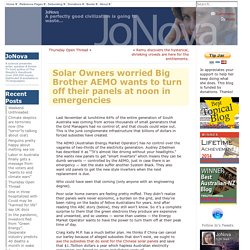
This is the junk conglomerate infrastructure that billions of dollars in forced subsidies have created. The AEMO (Australian Energy Market Operator) has no control over the vagaries of two-thirds of the electricity generation. Report: A Cloud Drifting Over a Solar Farm Knocked Out Power for 10hrs. Guest essay by Eric Worrall h/t Dr.

Willie Soon; an independent report blamed operator incompetence for allowing clouds to affect the solar energy supply. NT sacks energy chiefs after report into Alice Springs system blackGiles Parkinson 9 December 2019The Northern Territory Labor government has sacked the territory’s two most senior energy chiefs following a damming report from the market regulator into a “system black” event that hit the city of Alice Springs in October.Tim Duignan, the CEO of Territory Generation, and Michael Thompson, the head of network operator and systems control company Power and Water Corporation were both sacked after the government received a report from the Utilities Commission into the outage, which affected 12,000 customers for between 30 minutes and 10 hours. The official report is available here.
The following is a video commentary on the story; Jeopardy: What happens when your single largest generator is uncontrolled and coordinated by clouds? Watch Western Australia. Western Australia is a giant experiment: Even the Energy Experts are saying solar is jeopardizing the grid — it’s “dumb” Watch this space — blackout coming, 3 years and counting… The Western Australian grid is a separate island from the rest of the nation.

It’s roughly a 2.5 GW system for 2.5 million people. WA is getting into trouble faster than nearly anywhere else. Solar PV is now up to …. something larger than 850MW (which is the size of the coal fired generator). Unreliable solar is now the largest single generator in the Western Australian grid. Oopsie solar-battery fail? Cloud causes System Black event at Alice Springs affecting thousands. Welcome to the new complexified energy grid where a cloud can cause a system black event — knocking out power for as much as nine hours.

This affected the hospital for 30 minutes and the prolonged problems caused many businesses and supermarkets to close. Alice Springs is an island microgrid servicing about 29,000 people in the centre of Australia. It was 38 degrees C yesterday when the power went out. Shame about those fridges and air conditioning units. Alice Springs is a mini version of larger grids showing how fragile these new complicated systems of multiple generators based on weather events and batteries can be. Looks modern, sometimes has electricity too. Yesterday: Thousands impacted by Alice Springs power blackout* Steve Vivian, ABC News. Solar energy may have caused California’s wildfires. Solar overload — “Costs a fortune” as the super Duck Curve flood of electricity hits Australia. Ladies and Gentlemen, Australia is now romping in as Star-Crash-Test-Dummy in the renewables stake.

JoNova. More wind and solar than SA can use — we threw away 10% of the generation. South Australians have so much wind power, too much, that in Quarter 3 last year the AEMO had to intervene to cut off excess wind and solar generation.
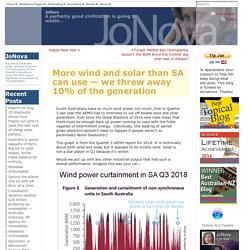
Ever since the Great Blackout of 2016 new rules mean that there must be enough back up power running to cope with the fickle vagaries of intermittent energy. (Obviously, this wasting of sacred green electrons wouldn’t need to happen if people weren’t so persnickety about blackouts!) This graph is from the Quarter 3 AEMO report for 2018. It is technically about both wind and solar, but it appears to be mostly wind. Solar is not a star player in Q3 because it’s winter. Report on Aug 25 blackouts shows how fragile our grid is (and the real cost of cheap solar panels). Badly installed solar PV makes Australia’s grid fragile On August 25 last year there was nearly a system black when, improbably, three states of Australia were islanded by one lightning strike.
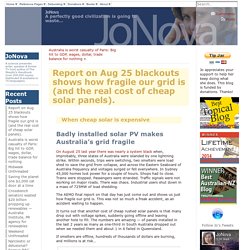
Within seconds, trips were switching, two smelters were load shed to save the grid from collapse, and across the Eastern Seaboard of Australia frequency and voltages surged or fell everywhere. In Sydney 45,000 homes lost power for a couple of hours. Shops had to close. Trains were stopped. Extraordinary powers triggered: Blackout threat from rooftop solar panels in Western Australia. White elephant solar panels: “force-feeding” high voltage, raising costs, breaking things, shutting themselves down. Some days I wonder if I should spread stories that make us sound like a recidivist third-world backwater struggling to maintain our voltage.
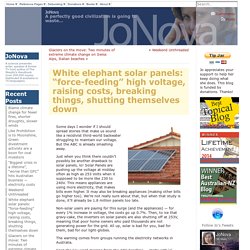
But the ABC is already smashing away. Just when you think there couldn’t possibly be another drawback to solar panels, lo! Solar Panels are pushing up the voltage at midday often as high as 253 Volts when it supposed to be more like 230 to 240V. This means appliances are using more electricity, that makes bills even higher.
Why Large Scale Solar Power Remains A Pipe Dream In India.